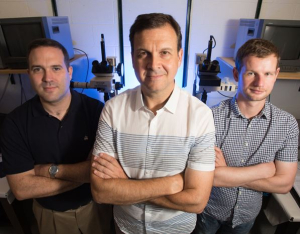The National Science Foundation has awarded $510,000 to Peter Vekilov, John and Rebecca Moores Professor of chemical and biomolecular engineering and chemistry, to conduct the first fundamental work about how the nature of solvents impact the crystallization process.
“This will be very cool because it will be the beginning of a new field of study,” said Vekilov who is one of the world’s leading experts in crystallization and pioneer of two-step nucleation, a revolutionary method of controlling the production of crystallization of proteins, which could lead to effective treatments for some diseases such as sickle cell anemia.
“Very cool” to him may just end up being groundbreaking to the rest of us.
While much is known about how organic crystals form in water-based solvents, not so with organic solvents.
“The level of understanding of the fundamental processes of crystal growth from organic solvents is severely limited,” said Vekilov. He calls it “the main obstacle to a rational approach to the optimization and control of crystallization in organic and mixed organic-aqueous media.”
It’s important
The biggest market for crystals is pharmaceutical. If you’ve ever taken Ibuprofen or Acetaminophen then you’ve swallowed little crystals. It’s a field in which Vekilov is expert.
He recently published an article shedding new light on how some of the most effective malaria drugs – those from the quinoline class – prevent the growth of hematin crystals, a key piece of the infection process, from taking place. The paper was co-authored by Jeffrey Rimer, Ernest J. and Barbara M. Henley Associate Professor of chemical and biomolecular engineering. Rimer joins Vekilov on this new work along with Jeremy Palmer, assistant professor.
In this grant for the work titled “Solvent-structuring at the interface between crystals and mixed organic-aqueous solvents,” the team will attempt to kill two birds with one stone, says Vekilov. One will be to understand the crystallization of organic solvents, and the other to understand the crystallization of hematin.
“The rate at which crystals grow depends on how fast bonds can form and the formation of the bonds is mediated by the solvent,” said Vekilov. “So we want to understand how the bonds form and how the solvents affect them so we can grow better organic crystals faster.”
Grow better crystals faster. Sounds groundbreaking, or cool, to borrow a phrase.
Team work
The project takes the form of experimental and computational work. Vekilov and Rimer will conduct the experiments using atomic force microscopes. Palmer will conduct the computer work.
The group will study around 20 molecules. They will modify the hematin to see which parts of the molecule are important for crystallization and which are not. Through the process they will better understand how the malaria parasites deals with the toxic hematin.
“You can design the drugs by knowing how, that’s crucial. Without knowing how you cannot design drugs,” said Vekilov.
He’s already working on the drug and treatment component with other support from the National Institutes of Health.
